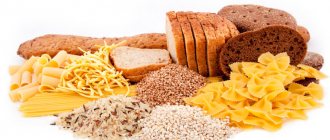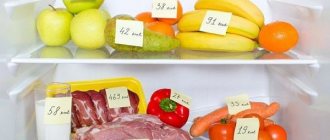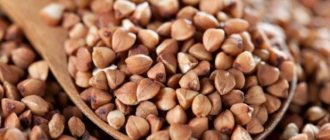Energy value of dietary nutrients
Food packaging typically states the energy, protein, carbohydrate and fat content. However, in some cases you have to count the calories in a product yourself.
The energy value of individual nutrients is shown in the table:
| Nutrient | Energy content, kcal/g |
| Squirrels | 4,1 |
| Fats | 9,3 |
| Carbohydrates | 4,1 |
| Ethanol | 7,1 |
| Alimentary fiber | 1,9 |
Alcoholic drinks are highly nutritious. So, a glass of beer adds 215 kcal to the energy balance, and a bottle of vodka – 1150 kcal.
How and why calorie needs are calculated
Energy requirements depend on the following factors:
- age;
- floor;
- height and weight;
- Nature of activity.
The average daily requirement for women is 2000 kcal, for men – 2500 kcal.
The required number of calories for a particular person is calculated according to the following algorithm:
- Determination of the basic level of exchange.
- Correction based on gender.
- Activity coefficient.
- Recalculation for weight loss or weight gain.
Determining the basic level of exchange
The calculation is carried out using regression equations:
E=M*10+ H *6.25-4.92* T
Where E is energy requirement, kcal; M—weight, kg; H—height in cm; T—age years. For a person aged 30 years, height 170 cm, weight 70 kg per day, 70 * 10 + 170 * 6.25-4.92 * 30 = 1615 kcal are required.
Gender adjustment
For a man we add 5 to the result, for a woman we subtract 161. We get the following numbers: 1620 and 1454 kcal.
Be sure to read: Diet with restriction of easily digestible carbohydrates for weight loss
Activity factor
Depending on your lifestyle, the result obtained is multiplied by a coefficient. For people engaged in sedentary work, it is equal to 1.2. For actors or regularly training athletes, the basic indicator is multiplied by 1.55. Professional athletes should use a coefficient of 1.9.
So, for a female accountant, the daily calorie intake is 1454 * 1.2 = 1745 kcal. The actress will need 1454*1.55=2254 kcal during rehearsals; weightlifter - 3078 kcal.
Correction for weight loss or weight gain
The calculations described are intended to maintain the weight from which calorie needs were calculated. If a person wants to lose weight, he should create a diet that is 20% deficient.
So, an actress who decided to lose extra pounds will need a daily intake of 2254 * 0.8 = 1803 kcal. A weightlifter will need 3078*1.2=3694 kcal to gain muscle mass. If you need to lose weight, you will have to be content with 3078*0.8=2462 kcal.
How to easily count calories and BJU (proteins, fats, carbohydrates)
Very often in training programs, when talking about nutrition, they recommend consuming a certain number of calories. For example, per kilogram of weight. They also call the required ratio of proteins, fats and carbohydrates (BJU). I don’t know about you, but this has always irritated me!
Let me imagine that I take a pack of pasta and carefully find out on the packaging how many calories, proteins, fats, and carbohydrates there are. And it says there how much of this is in just 100 grams of dry product. Soooo... how many grams are in a pack? How long should I cook? How can we now understand how much of everything we need in the ready-made ones - I cooked for several people... And if I didn’t cook, how much “raw” pasta did they swell in there? Damn, I don’t just eat pasta for lunch! HOW TO COUNT EVERYTHING!? Yes, even with all the paid calculator programs, I spend more time counting than cooking and eating! Live when??? Aaaaaaaaaaaaaa!!!!!!!!!!
Fortunately, it's not all that scary. And it’s not at all necessary to constantly chew and tap your fingers on a calculator, calculating the number of calories in peas, taking into account the coefficient of their boiling... And transferring the peas to the scales and back to the plate. Right in the restaurant. Right in front of the girl. Having previously picked out all the smoked meats from the peas. By the way, you need to remember to weigh them too! And count...
I'm not exaggerating too much. Personally, I always had such pictures before my eyes as soon as I heard or read the phrase “calorie counting.” I honestly even tried to count what I ate by entering data into calculator programs. While you enter your breakfast, while you estimate the weight of what you ate... I couldn’t stand it for more than one day. This is unreal!
But it turns out that there is a completely understandable, simple and convenient scheme for how to count calories and nutritional supplements . But all sorts of “nutritionists” and “fitness instructors” hide it. Otherwise, how would they explain that they calculated your diet in a few minutes, but charged a lot of money for it? This is individual and personal for you! So consider me to be on topic here. For free.
And this is how it works. A similar scheme is used and has already been discussed a little on TrainAtHome.ru in an article about the power supply system for ground and for terrain. We will now simply analyze the mechanism so that from now on we can confidently figure out for ourselves how and what we eat, so that it corresponds to the recommendations of any training program. And it didn't take much time. And nerves (this is important for me - numbers always make me nervous!).
The methodology is based on a system of measuring foods using portions . Each of the food categories refers to either proteins , fats , or carbohydrates . Or to several nutrients at once. And we will know this. Just like the fact that each serving has its own calorie content .
Table of food servings with calorie content
As you can see, we don’t really have a BZHU here. That is, “proteins” and “fats” are highlighted (I will write food groups in quotes so that it is clear when I mean a product and when a nutrient). And instead of carbohydrates - “starches”, and “fruits”, and “vegetables”. And then there are “legumes”, “liquid carbohydrates” and “liquid proteins” . Therefore, in addition to the table, we also need to know the following:
Starches , fruits and vegetables are carbohydrates. Calories from carbohydrates are distributed among these food groups.
A portion of “proteins” contains both proteins and fats. That is, the calories needed from both proteins and fats are added up and consist of servings of “proteins.”
If we need to add 1 serving of “fat” , then we remove 1 serving of “protein” from the diet.
1 serving of “legumes” = 1 serving of “starches” + 1 serving of “proteins”
“Legumes” can be replaced with “ liquid proteins” (they count the same way: 1 portion of starches + 1 portion of proteins)
"Fruits" are replaced by " liquid carbohydrates"
It seems that everything is also somehow confused. But further we will analyze this and see that there is nothing really complicated. Sometimes, to create a diet, we need to know how many calories are in proteins, fats and carbohydrates. It's quite simple:
1 g protein = 4 kcal
1 g carbohydrates = 4 kcal
1 g fat = 9 kcal
Please note that proteins and carbohydrates contain equal amounts of calories. And there are more than twice as many calories per gram of fat. This is why we ask you to be careful with fats.
Now a few words about the portions themselves and the products. Everything except “proteins” is measured visually - in glasses, spoons and pieces . And everything is measured as cooked! First, you can actually place the finished products in a glass and see how many servings you get (even in a restaurant, if you have time for it). But very quickly you will be able to determine by eye how many servings of vegetables are in the salad on your plate. Or how much of it to put in from a common bowl.
Servings of " protein" are measured in grams . But here you will soon get used to it too. Meat portions of 120 grams are usually served - that’s 4 servings. There is a range from 100 to 150 (for example, in a meat cutlet). But roughly it turns out to be 4 servings of “protein” on a plate. A large steak or whole chicken breast is almost 2 times as much (6-8 servings of “protein”). Chicken breasts (and this is the basis of the sports protein diet of all countries and peoples), for example, lose almost no weight when cooked. A kilogram of breasts is 4-5 pieces. In general, it’s also not as difficult as the calorie content of 100 grams of dry pasta. I hope I didn't confuse anyone.
In this case, estimating by eye is not so scary. There are guidelines. You won’t achieve jewel-like precision - in some places it will be less, and in others it will be more. But jewelry precision is not needed. After all, the amount of calories recommended for consumption is also approximate. It's very difficult to actually calculate how much you actually spend. The main thing is that you keep your diet under control .
As for the set of products in the serving table. It is, of course, incomplete. But it seems to me that it will not be difficult for you to supplement it yourself. The basic principle is clearly visible there.
Now that we are armed with all the necessary tools, we can begin to compile this very diet . This is the only time we need a calculator. That is, about once a month, and not every day after each meal.
This all goes through the following algorithm. We have a daily calorie requirement . It is calculated differently - depending on the training program or some kind of nutrition concept that you must adhere to. There are so many of them that we won’t discuss them all here. But below I will give a specific example of creating a diet. And we have BJU ratios . That is, what should our daily calories consist of?
The BJU ratio can be given as a percentage of the daily value . That is, how many calories should we take from proteins, how many from fats, and how many from carbohydrates.
There is also a form when the number of grams of proteins, fats and carbohydrates per unit of weight . Then we will still need to convert proteins, fats and carbohydrates separately into calories (see how above).
Next, we take the number of calories from proteins and add to them the number of calories from fat . And divide this by the number of calories in a serving of “protein.” Let's look at the table: a serving of “proteins” contains 45 kcal. We get the number of servings of “proteins” per day.
Let me remind you once again that meat, cottage cheese and fish contain fats . We try to eat low-fat foods, but they are called that by convention. It’s just that fatty meat contains 1.5-2 times more fat than protein, for example. But we also use fats in their pure form - for dressing salads, for example. Or we snack on nuts, and they are in our “fats” group. That’s why we have separated “fats” into a separate group. We take the number of servings we need (from 1 to 8, if you are losing weight - less, if you are gaining - more) and subtract it from the number of servings of “proteins” . The BJU has sorted out the proteins and fats. There are carbohydrates left.
But with carbohydrates it’s the other way around - they consist of several food groups.
First, let's deal with the “vegetables” . Vegetables are the healthiest carbohydrates and fiber. So we’ll make a place for them. Somewhere at least 4 servings should be taken. 1 serving of “vegetables” = 25 calories. That is, we subtract 100 calories from carbohydrates (4 servings). And we divide the remainder by 80 kcal (a serving of “ starches” and a serving of “ fruit” have the same number of calories). And divide by 2. We get the number of servings of “starches” and “fruits” - it will be approximately equal. Approximately, because there are odd numbers. I would give more fruit... or add legumes .
Yes. What about legumes? I love beans and milk. But when I know the number of servings of "protein" and "starches", I subtract one serving from there and get one glass of milk (1 serving of "liquid proteins" = 1 serving of "legumes" = 1 serving of "starches" + 1 serving of "protein") . Need space for beans? I also reduce “proteins” and “starches” and add “legumes”.
Once again I want to say that everything looks terrible in theory. But in practice everything is very simple. Let's look at a real example from a real training program I'm planning to start.
An example of preparing a diet taking into account calorie content and BZHU standards
So, the nutritional instructions for my training program say that I should take:
- Squirrels. 1.5 g per pound
- Fats. 0.5 g per pound
- Carbohydrates. 1.5 g per pound
I weigh about 83 kg. Need to convert to pounds (1 pound = 0.454 kg). And calculate how much BJU I need to eat in grams. It turns out:
- Squirrels. 83/0.454 * 1.5 = 274 g
- Fats. 83/0.454 * 0.5 = 91 g
- Carbohydrates. 83/0.454 * 1.5 = 274 g
Now we convert the obtained values into calories. We get
- Squirrels. 274 * 4 = 1096 kcal
- Fats. 91 * 9 = 819 kcal
- Proteins + fats. 1096+819 = 1915 kcal
- Carbohydrates. 274 * 4 = 1096 kcal
Determining the number of servings
- Proteins and fats.
I have
4 servings of “fat” . I know from experience what I need for yolks in scrambled eggs and oil for dressing coleslaw. I count the servings of “proteins”: 1915 kcal / 45 kcal - 4 servings = 38 servings of proteins. - Carbohydrates . We add 4 servings of “vegetables” . This is 100 kcal. That leaves 1096-100=996 kcal for fruits and starches. 996 / 80 calories = 12.45. Divide by 2. We get 6 servings of “fruits” and 6 servings of “starches” . There is some leftover - give the vegetables another 1 serving. Total, 5 servings of “vegetables”.
The result was a diet of 6 servings of “starches”, 6 servings of “fruits”, 5 servings of “vegetables”, 38 servings of “protein” and 4 servings of “fats”. But there are also legumes. I like to mix protein with milk (this is 1 serving of legumes) and eat pea or bean soup (this is 2 more servings of legumes). Total 3 servings of “legumes”. We subtract this figure from “proteins” (38-3=35) and from “starches” (6-3=3). Final result:
- "Starches" - 3 servings
- Legumes or Liquid Proteins - 3 servings
- "Fruit" or "Liquid Carbs" - 6 servings
- “Vegetables” – 5 servings
- “Proteins” – 35 servings
- “Fats” – 4 servings
After that, I write down the above number of servings in a notebook. And based on this record, I create a diet. You can do it in advance. Or you can do it intuitively by placing chopsticks in a notebook opposite groups of portions. This is what my menu looks like.
- Before training (I train in the morning) - tea with honey (honey is fructose, a natural gainer, see the table - 1 “fruit” ), a protein shake with water (2 tablespoons of protein - 4 “proteins” )
- After training - a cocktail (2 tablespoons of protein - 4 "proteins" , 1 glass of juice - 2 "liquid carbohydrates" )
- Breakfast - an omelet of 2 eggs ( 1 “white”, 2 “fat” ), 2 toasts with cottage cheese ( 2 “starch”, 1 “white” ), sauerkraut and carrots in Korean ( 2 “vegetables” )
- Snack – protein shake with milk ( 4 “proteins”, 1 “liquid proteins” ), apple ( 1 “fruit” )
- Lunch - bean soup ( 2 “legumes” , 1 “starch” ), a can of tuna ( 6 “protein” ), cabbage salad with olive oil ( 1 “vegetable”, 1 “fat” )
- Snack – protein shake with water ( 4 “proteins” ), nuts ( 1 “fat” ), banana ( 2 “fruits” )
- Dinner - grilled chicken breast (210 g - 7 "proteins" ), stewed green beans (1 "vegetable" ), pickled beets ( 1 "vegetable" )
- At night - a pack of cottage cheese ( 4 “whites” )
That's all. It took me about 15 minutes to figure this out. But even if you spend an hour, it will still save you time than if you counted calories and dietary fat rather than portions.
Don't be intimidated by this "food list". 3000 calories is quite a lot. Designed for an adult man and heavy training. You may have a completely different picture. It all depends on you, your training program and your daily routine.
There are also few fresh vegetables on the menu. Because it's winter and they're tasteless in stores. With the advent of good vegetables, all sorts of pickles and pickles will disappear from the list. Of course, I also change other products almost every day. Chicken breasts for cutlets, tuna for beef. I make different dishes, etc. But in general, the menu has exactly this appearance and routine.
And a few more recommendations for creating a diet:
- Keep a food diary . This is for your own convenience - to get the diet that is acceptable to you. And all you need to do in this diary is to check the boxes next to the required number of servings. If you ate an apple, you checked the box next to “fruit.” After a certain time, there will be no need for a diary - you will clearly understand how, what and how much you eat.
- Throughout the day, move from “fruits” and “starches” to “proteins” and “vegetables . That is, in the first half of the day, load up on carbohydrates - you need energy. And in the second, we use proteins and fiber to build and restore the body, and facilitate the functioning of the gastrointestinal tract.
- If you are gaining weight and it is difficult to eat a lot, then try to drink calories. Make protein-carbohydrate cocktails, drink milk and juices. If you are losing weight, then, on the contrary, do not drink calories, but chew them more . Vegetables, for example, take up a lot of space in the stomach and contain few calories.
- Soups are a great topic when you are losing weight and are constantly hungry. It’s difficult to “count” them, but you can get used to them. Especially when you get used to measuring food by eye (by the volume of the glass).
The article turned out to be quite cumbersome. But I hope it's understandable. Counting calories is not the easiest thing to practice. But now it has become much easier. Of course, there are certain errors, conventions and assumptions. But even professional athletes with their nutritionists cannot count everything 100%. Only in laboratory conditions. But who would want to live there?
Dmitry Gudkov
How to calculate the energy content of a diet
Those who are going to lose weight, or vice versa, build muscle mass, need to take into account every bite eaten and record it in a diary. Sometimes it is not clear from the information on the label what volume the calorie content is for.
For example, a bottle of milk says that it contains 3% protein, 2.5% fat, 4.7% carbohydrates, 53 kcal. We check the number of calories per 100 ml: 3*4.1+2.5*9.3+4.7*4.1=54.8.
Therefore, the nutritional value of 0.1 liter of milk is indicated on the package. If, after compiling the diet, it turns out that you need to add 148 calories, this can be done by adding 148/53*100=280 ml of milk.
BZHU weight loss calculator
You can independently organize high-quality nutrition, in which proteins and carbohydrates are in the optimal ratio. The norm of KBZHU is derived based on exact indicators of age, height, weight, lifestyle and gender. Using an online calculator, calculating the daily calorie limit for weight loss becomes a matter of a couple of minutes. It is enough to enter the data in the fields of the form and receive detailed recommendations on the composition of food for effective weight loss.
The calculator shows how much BJU you need per day to lose weight naturally:
- according to the Harris-Benedict formula - an equation for estimating the basal metabolic rate;
- according to the Mifflin-San Geor formula - an improved method for calculating metabolism, adapted to modern living conditions;
- daily protein intake - vital amino acids necessary for the healthy functionality of the whole body;
- recommended fat intake;
- carbohydrate norm.
The program calculates the intake norms for calories, proteins, fats and carbohydrates based on several classical formulas commonly used in dietetics, including for therapeutic purposes. One of the most important criteria is the activity coefficient. Lifestyle completely determines the calorie content of the weight loss menu. The following indicators are included in the calculation:
- sedentary, sedentary lifestyle, lack or minimal physical activity;
- light load, sports 1-3 times a week;
- average activity commensurate with sports training 3-5 times a week;
- high level of physical activity, with daily training;
- ultra intense load (as a rule, we are talking about athletes during preparation for competitions).
The active coefficient includes all daily activity - walking, physical work, playing any sport, even the number of climbs to the upper floors. For example, if a person sits in the office all day and activity is limited only to going to the nearest store, in the “Lifestyle” line you should select the “Sedentary and sedentary” item.









